Impact of COVID-19 and Talent Management in The Hoxton Hotel
VerifiedAdded on 2022/12/22
|33
|7865
|22
Report
AI Summary
This report investigates the impact of COVID-19 on The Hoxton hotel, London, and the role of talent management in mitigating its effects. The study employs primary and secondary research methods, including questionnaires and literature reviews, to analyze the pandemic's influence on business operations. Key findings highlight the importance of employee engagement, positive employee experience, workplace optimization, and motivational techniques in maximizing workforce contributions during uncertain times. The research concludes that effective talent management strategies are crucial for human resource management, enabling organizations to develop competitive advantages and navigate the dynamic external environment. The report also explores the limitations, such as confidential information and limited data availability, that may affect the scope of future research. It examines the practical benefits for employees, society, and customers, focusing on skill development and improved service during the pandemic.
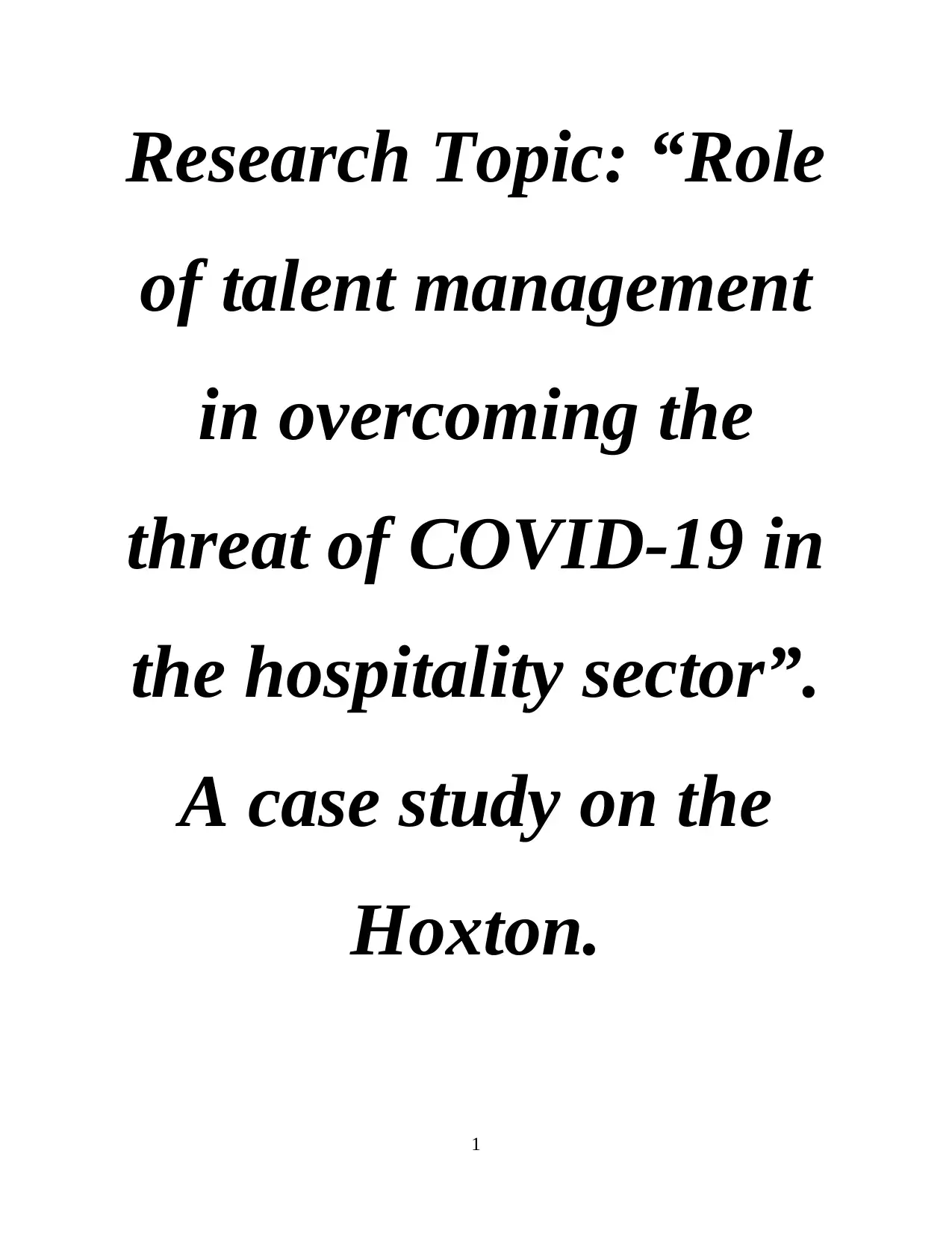
Research Topic: “Role
of talent management
in overcoming the
threat of COVID-19 in
the hospitality sector”.
A case study on the
Hoxton.
1
of talent management
in overcoming the
threat of COVID-19 in
the hospitality sector”.
A case study on the
Hoxton.
1
Paraphrase This Document
Need a fresh take? Get an instant paraphrase of this document with our AI Paraphraser
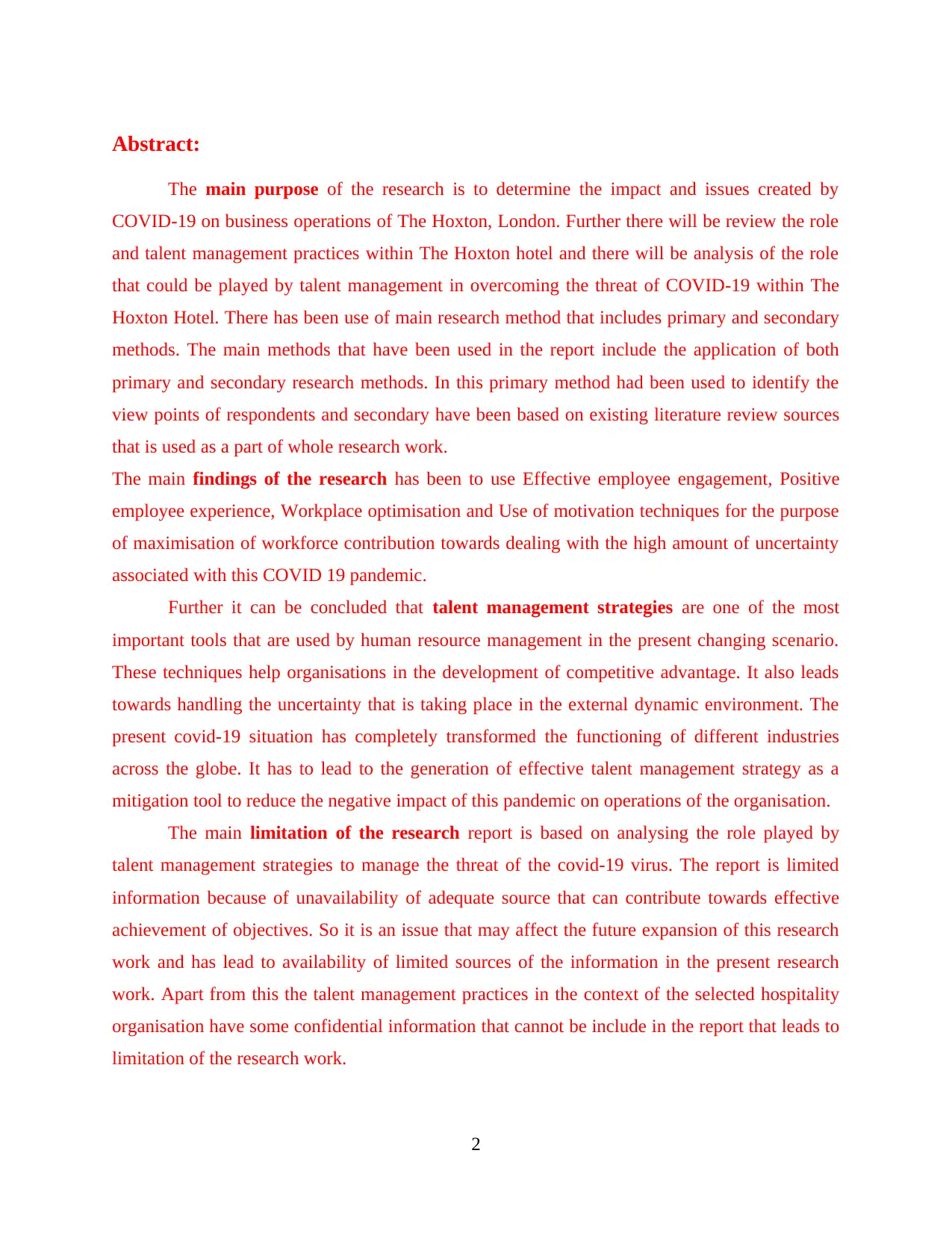
Abstract:
The main purpose of the research is to determine the impact and issues created by
COVID-19 on business operations of The Hoxton, London. Further there will be review the role
and talent management practices within The Hoxton hotel and there will be analysis of the role
that could be played by talent management in overcoming the threat of COVID-19 within The
Hoxton Hotel. There has been use of main research method that includes primary and secondary
methods. The main methods that have been used in the report include the application of both
primary and secondary research methods. In this primary method had been used to identify the
view points of respondents and secondary have been based on existing literature review sources
that is used as a part of whole research work.
The main findings of the research has been to use Effective employee engagement, Positive
employee experience, Workplace optimisation and Use of motivation techniques for the purpose
of maximisation of workforce contribution towards dealing with the high amount of uncertainty
associated with this COVID 19 pandemic.
Further it can be concluded that talent management strategies are one of the most
important tools that are used by human resource management in the present changing scenario.
These techniques help organisations in the development of competitive advantage. It also leads
towards handling the uncertainty that is taking place in the external dynamic environment. The
present covid-19 situation has completely transformed the functioning of different industries
across the globe. It has to lead to the generation of effective talent management strategy as a
mitigation tool to reduce the negative impact of this pandemic on operations of the organisation.
The main limitation of the research report is based on analysing the role played by
talent management strategies to manage the threat of the covid-19 virus. The report is limited
information because of unavailability of adequate source that can contribute towards effective
achievement of objectives. So it is an issue that may affect the future expansion of this research
work and has lead to availability of limited sources of the information in the present research
work. Apart from this the talent management practices in the context of the selected hospitality
organisation have some confidential information that cannot be include in the report that leads to
limitation of the research work.
2
The main purpose of the research is to determine the impact and issues created by
COVID-19 on business operations of The Hoxton, London. Further there will be review the role
and talent management practices within The Hoxton hotel and there will be analysis of the role
that could be played by talent management in overcoming the threat of COVID-19 within The
Hoxton Hotel. There has been use of main research method that includes primary and secondary
methods. The main methods that have been used in the report include the application of both
primary and secondary research methods. In this primary method had been used to identify the
view points of respondents and secondary have been based on existing literature review sources
that is used as a part of whole research work.
The main findings of the research has been to use Effective employee engagement, Positive
employee experience, Workplace optimisation and Use of motivation techniques for the purpose
of maximisation of workforce contribution towards dealing with the high amount of uncertainty
associated with this COVID 19 pandemic.
Further it can be concluded that talent management strategies are one of the most
important tools that are used by human resource management in the present changing scenario.
These techniques help organisations in the development of competitive advantage. It also leads
towards handling the uncertainty that is taking place in the external dynamic environment. The
present covid-19 situation has completely transformed the functioning of different industries
across the globe. It has to lead to the generation of effective talent management strategy as a
mitigation tool to reduce the negative impact of this pandemic on operations of the organisation.
The main limitation of the research report is based on analysing the role played by
talent management strategies to manage the threat of the covid-19 virus. The report is limited
information because of unavailability of adequate source that can contribute towards effective
achievement of objectives. So it is an issue that may affect the future expansion of this research
work and has lead to availability of limited sources of the information in the present research
work. Apart from this the talent management practices in the context of the selected hospitality
organisation have some confidential information that cannot be include in the report that leads to
limitation of the research work.
2
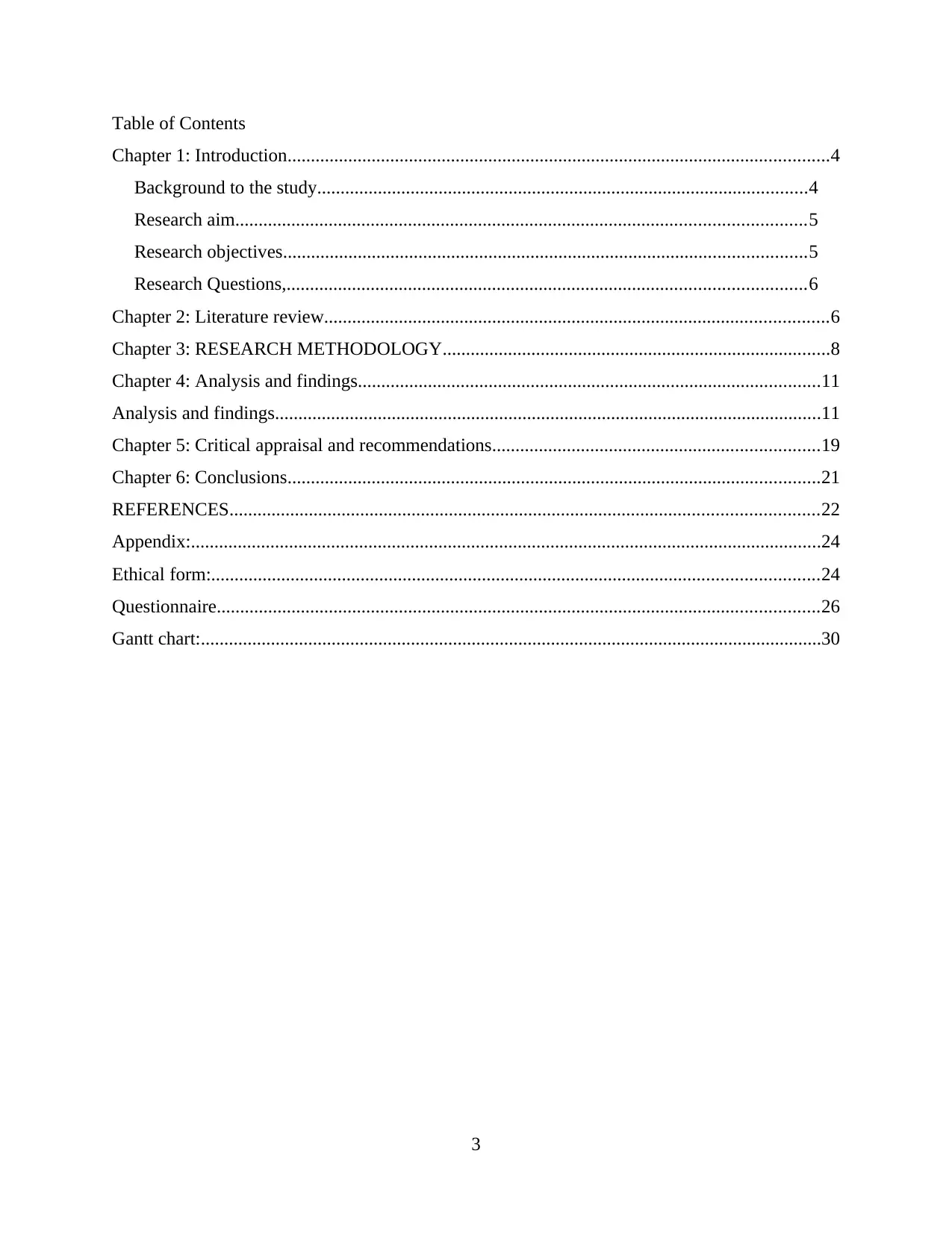
Table of Contents
Chapter 1: Introduction....................................................................................................................4
Background to the study.........................................................................................................4
Research aim..........................................................................................................................5
Research objectives................................................................................................................5
Research Questions,...............................................................................................................6
Chapter 2: Literature review............................................................................................................6
Chapter 3: RESEARCH METHODOLOGY...................................................................................8
Chapter 4: Analysis and findings...................................................................................................11
Analysis and findings.....................................................................................................................11
Chapter 5: Critical appraisal and recommendations......................................................................19
Chapter 6: Conclusions..................................................................................................................21
REFERENCES..............................................................................................................................22
Appendix:.......................................................................................................................................24
Ethical form:..................................................................................................................................24
Questionnaire.................................................................................................................................26
Gantt chart:.....................................................................................................................................30
3
Chapter 1: Introduction....................................................................................................................4
Background to the study.........................................................................................................4
Research aim..........................................................................................................................5
Research objectives................................................................................................................5
Research Questions,...............................................................................................................6
Chapter 2: Literature review............................................................................................................6
Chapter 3: RESEARCH METHODOLOGY...................................................................................8
Chapter 4: Analysis and findings...................................................................................................11
Analysis and findings.....................................................................................................................11
Chapter 5: Critical appraisal and recommendations......................................................................19
Chapter 6: Conclusions..................................................................................................................21
REFERENCES..............................................................................................................................22
Appendix:.......................................................................................................................................24
Ethical form:..................................................................................................................................24
Questionnaire.................................................................................................................................26
Gantt chart:.....................................................................................................................................30
3
⊘ This is a preview!⊘
Do you want full access?
Subscribe today to unlock all pages.

Trusted by 1+ million students worldwide
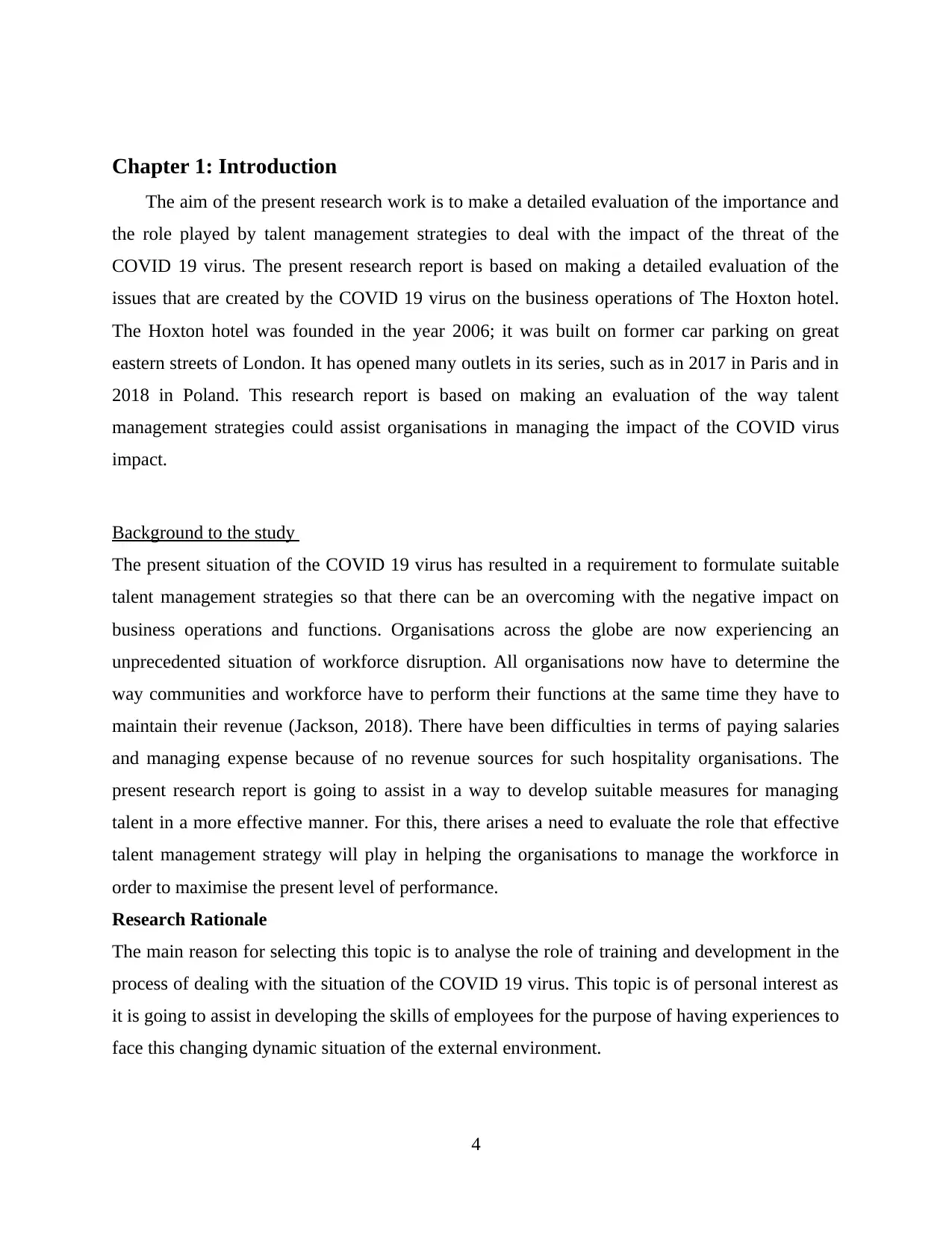
Chapter 1: Introduction
The aim of the present research work is to make a detailed evaluation of the importance and
the role played by talent management strategies to deal with the impact of the threat of the
COVID 19 virus. The present research report is based on making a detailed evaluation of the
issues that are created by the COVID 19 virus on the business operations of The Hoxton hotel.
The Hoxton hotel was founded in the year 2006; it was built on former car parking on great
eastern streets of London. It has opened many outlets in its series, such as in 2017 in Paris and in
2018 in Poland. This research report is based on making an evaluation of the way talent
management strategies could assist organisations in managing the impact of the COVID virus
impact.
Background to the study
The present situation of the COVID 19 virus has resulted in a requirement to formulate suitable
talent management strategies so that there can be an overcoming with the negative impact on
business operations and functions. Organisations across the globe are now experiencing an
unprecedented situation of workforce disruption. All organisations now have to determine the
way communities and workforce have to perform their functions at the same time they have to
maintain their revenue (Jackson, 2018). There have been difficulties in terms of paying salaries
and managing expense because of no revenue sources for such hospitality organisations. The
present research report is going to assist in a way to develop suitable measures for managing
talent in a more effective manner. For this, there arises a need to evaluate the role that effective
talent management strategy will play in helping the organisations to manage the workforce in
order to maximise the present level of performance.
Research Rationale
The main reason for selecting this topic is to analyse the role of training and development in the
process of dealing with the situation of the COVID 19 virus. This topic is of personal interest as
it is going to assist in developing the skills of employees for the purpose of having experiences to
face this changing dynamic situation of the external environment.
4
The aim of the present research work is to make a detailed evaluation of the importance and
the role played by talent management strategies to deal with the impact of the threat of the
COVID 19 virus. The present research report is based on making a detailed evaluation of the
issues that are created by the COVID 19 virus on the business operations of The Hoxton hotel.
The Hoxton hotel was founded in the year 2006; it was built on former car parking on great
eastern streets of London. It has opened many outlets in its series, such as in 2017 in Paris and in
2018 in Poland. This research report is based on making an evaluation of the way talent
management strategies could assist organisations in managing the impact of the COVID virus
impact.
Background to the study
The present situation of the COVID 19 virus has resulted in a requirement to formulate suitable
talent management strategies so that there can be an overcoming with the negative impact on
business operations and functions. Organisations across the globe are now experiencing an
unprecedented situation of workforce disruption. All organisations now have to determine the
way communities and workforce have to perform their functions at the same time they have to
maintain their revenue (Jackson, 2018). There have been difficulties in terms of paying salaries
and managing expense because of no revenue sources for such hospitality organisations. The
present research report is going to assist in a way to develop suitable measures for managing
talent in a more effective manner. For this, there arises a need to evaluate the role that effective
talent management strategy will play in helping the organisations to manage the workforce in
order to maximise the present level of performance.
Research Rationale
The main reason for selecting this topic is to analyse the role of training and development in the
process of dealing with the situation of the COVID 19 virus. This topic is of personal interest as
it is going to assist in developing the skills of employees for the purpose of having experiences to
face this changing dynamic situation of the external environment.
4
Paraphrase This Document
Need a fresh take? Get an instant paraphrase of this document with our AI Paraphraser
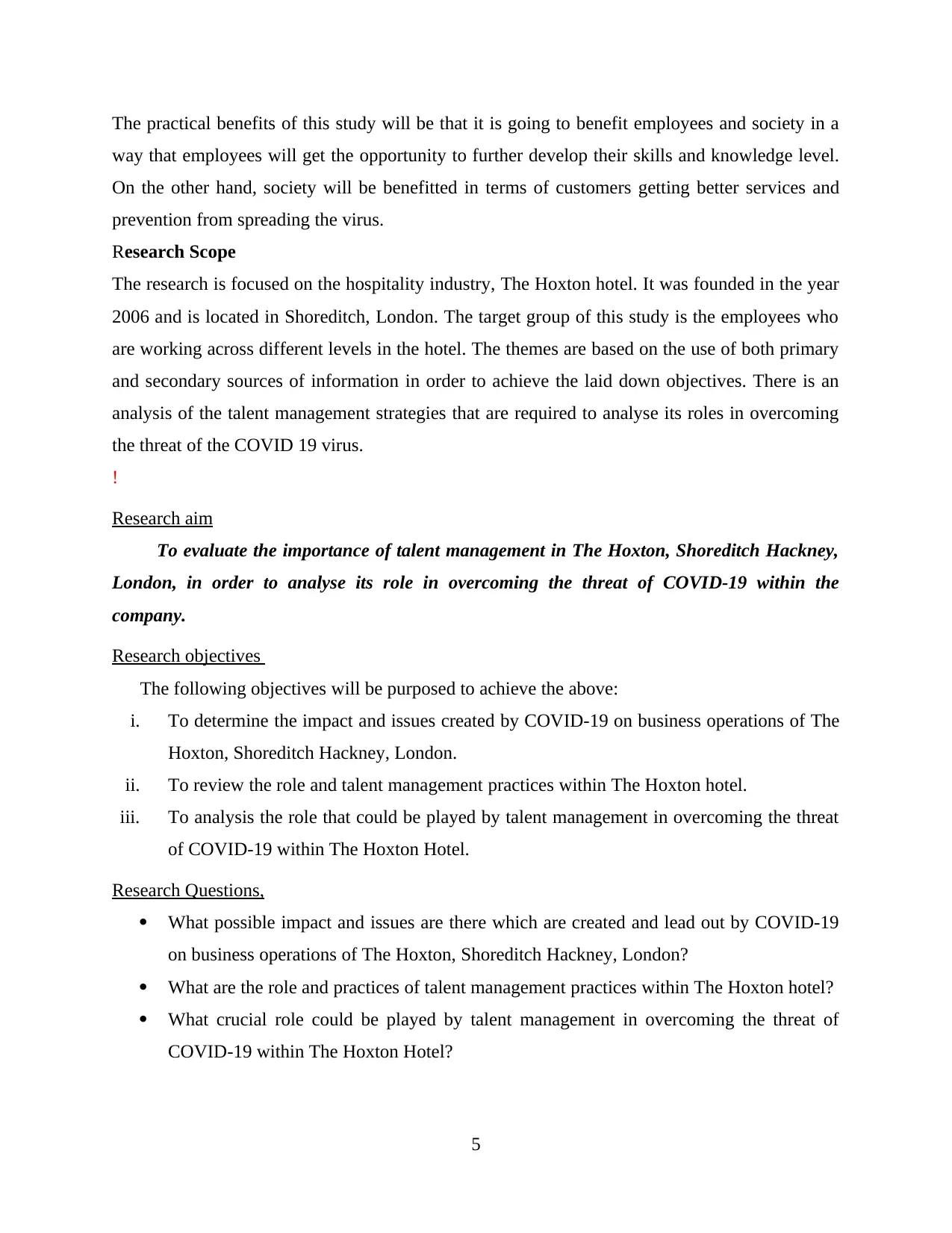
The practical benefits of this study will be that it is going to benefit employees and society in a
way that employees will get the opportunity to further develop their skills and knowledge level.
On the other hand, society will be benefitted in terms of customers getting better services and
prevention from spreading the virus.
Research Scope
The research is focused on the hospitality industry, The Hoxton hotel. It was founded in the year
2006 and is located in Shoreditch, London. The target group of this study is the employees who
are working across different levels in the hotel. The themes are based on the use of both primary
and secondary sources of information in order to achieve the laid down objectives. There is an
analysis of the talent management strategies that are required to analyse its roles in overcoming
the threat of the COVID 19 virus.
!
Research aim
To evaluate the importance of talent management in The Hoxton, Shoreditch Hackney,
London, in order to analyse its role in overcoming the threat of COVID-19 within the
company.
Research objectives
The following objectives will be purposed to achieve the above:
i. To determine the impact and issues created by COVID-19 on business operations of The
Hoxton, Shoreditch Hackney, London.
ii. To review the role and talent management practices within The Hoxton hotel.
iii. To analysis the role that could be played by talent management in overcoming the threat
of COVID-19 within The Hoxton Hotel.
Research Questions,
What possible impact and issues are there which are created and lead out by COVID-19
on business operations of The Hoxton, Shoreditch Hackney, London?
What are the role and practices of talent management practices within The Hoxton hotel?
What crucial role could be played by talent management in overcoming the threat of
COVID-19 within The Hoxton Hotel?
5
way that employees will get the opportunity to further develop their skills and knowledge level.
On the other hand, society will be benefitted in terms of customers getting better services and
prevention from spreading the virus.
Research Scope
The research is focused on the hospitality industry, The Hoxton hotel. It was founded in the year
2006 and is located in Shoreditch, London. The target group of this study is the employees who
are working across different levels in the hotel. The themes are based on the use of both primary
and secondary sources of information in order to achieve the laid down objectives. There is an
analysis of the talent management strategies that are required to analyse its roles in overcoming
the threat of the COVID 19 virus.
!
Research aim
To evaluate the importance of talent management in The Hoxton, Shoreditch Hackney,
London, in order to analyse its role in overcoming the threat of COVID-19 within the
company.
Research objectives
The following objectives will be purposed to achieve the above:
i. To determine the impact and issues created by COVID-19 on business operations of The
Hoxton, Shoreditch Hackney, London.
ii. To review the role and talent management practices within The Hoxton hotel.
iii. To analysis the role that could be played by talent management in overcoming the threat
of COVID-19 within The Hoxton Hotel.
Research Questions,
What possible impact and issues are there which are created and lead out by COVID-19
on business operations of The Hoxton, Shoreditch Hackney, London?
What are the role and practices of talent management practices within The Hoxton hotel?
What crucial role could be played by talent management in overcoming the threat of
COVID-19 within The Hoxton Hotel?
5
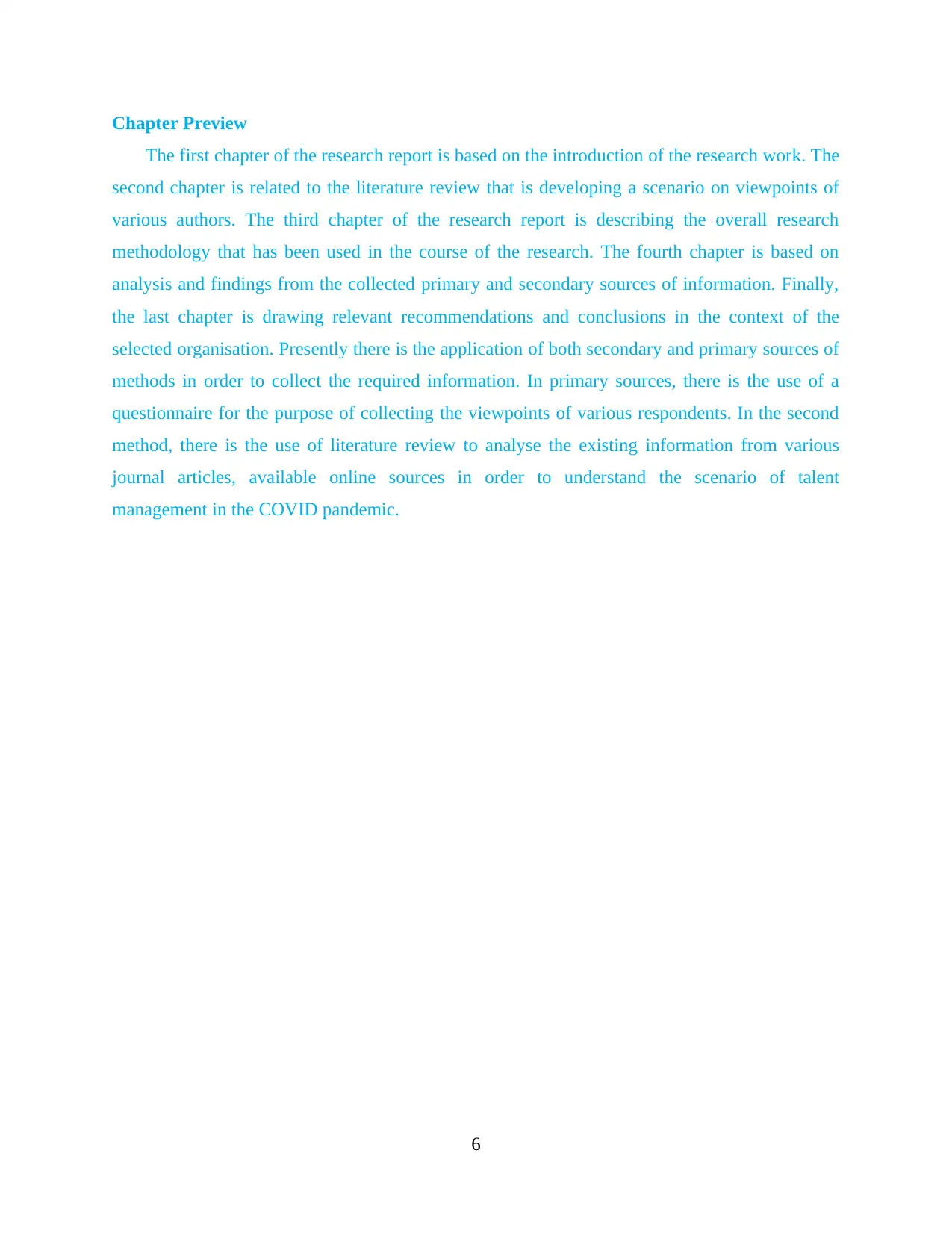
Chapter Preview
The first chapter of the research report is based on the introduction of the research work. The
second chapter is related to the literature review that is developing a scenario on viewpoints of
various authors. The third chapter of the research report is describing the overall research
methodology that has been used in the course of the research. The fourth chapter is based on
analysis and findings from the collected primary and secondary sources of information. Finally,
the last chapter is drawing relevant recommendations and conclusions in the context of the
selected organisation. Presently there is the application of both secondary and primary sources of
methods in order to collect the required information. In primary sources, there is the use of a
questionnaire for the purpose of collecting the viewpoints of various respondents. In the second
method, there is the use of literature review to analyse the existing information from various
journal articles, available online sources in order to understand the scenario of talent
management in the COVID pandemic.
6
The first chapter of the research report is based on the introduction of the research work. The
second chapter is related to the literature review that is developing a scenario on viewpoints of
various authors. The third chapter of the research report is describing the overall research
methodology that has been used in the course of the research. The fourth chapter is based on
analysis and findings from the collected primary and secondary sources of information. Finally,
the last chapter is drawing relevant recommendations and conclusions in the context of the
selected organisation. Presently there is the application of both secondary and primary sources of
methods in order to collect the required information. In primary sources, there is the use of a
questionnaire for the purpose of collecting the viewpoints of various respondents. In the second
method, there is the use of literature review to analyse the existing information from various
journal articles, available online sources in order to understand the scenario of talent
management in the COVID pandemic.
6
⊘ This is a preview!⊘
Do you want full access?
Subscribe today to unlock all pages.

Trusted by 1+ million students worldwide
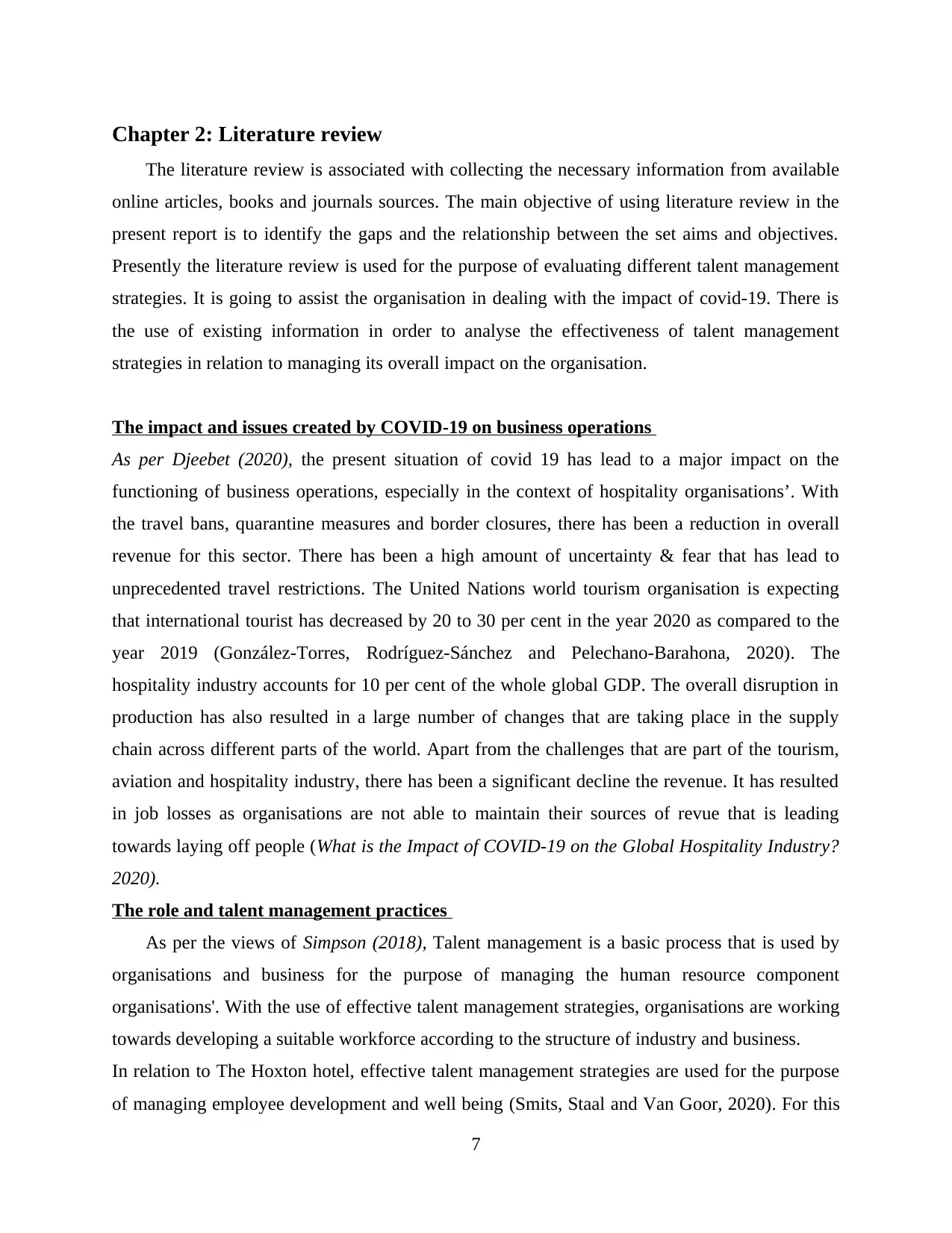
Chapter 2: Literature review
The literature review is associated with collecting the necessary information from available
online articles, books and journals sources. The main objective of using literature review in the
present report is to identify the gaps and the relationship between the set aims and objectives.
Presently the literature review is used for the purpose of evaluating different talent management
strategies. It is going to assist the organisation in dealing with the impact of covid-19. There is
the use of existing information in order to analyse the effectiveness of talent management
strategies in relation to managing its overall impact on the organisation.
The impact and issues created by COVID-19 on business operations
As per Djeebet (2020), the present situation of covid 19 has lead to a major impact on the
functioning of business operations, especially in the context of hospitality organisations’. With
the travel bans, quarantine measures and border closures, there has been a reduction in overall
revenue for this sector. There has been a high amount of uncertainty & fear that has lead to
unprecedented travel restrictions. The United Nations world tourism organisation is expecting
that international tourist has decreased by 20 to 30 per cent in the year 2020 as compared to the
year 2019 (González-Torres, Rodríguez-Sánchez and Pelechano-Barahona, 2020). The
hospitality industry accounts for 10 per cent of the whole global GDP. The overall disruption in
production has also resulted in a large number of changes that are taking place in the supply
chain across different parts of the world. Apart from the challenges that are part of the tourism,
aviation and hospitality industry, there has been a significant decline the revenue. It has resulted
in job losses as organisations are not able to maintain their sources of revue that is leading
towards laying off people (What is the Impact of COVID-19 on the Global Hospitality Industry?
2020).
The role and talent management practices
As per the views of Simpson (2018), Talent management is a basic process that is used by
organisations and business for the purpose of managing the human resource component
organisations'. With the use of effective talent management strategies, organisations are working
towards developing a suitable workforce according to the structure of industry and business.
In relation to The Hoxton hotel, effective talent management strategies are used for the purpose
of managing employee development and well being (Smits, Staal and Van Goor, 2020). For this
7
The literature review is associated with collecting the necessary information from available
online articles, books and journals sources. The main objective of using literature review in the
present report is to identify the gaps and the relationship between the set aims and objectives.
Presently the literature review is used for the purpose of evaluating different talent management
strategies. It is going to assist the organisation in dealing with the impact of covid-19. There is
the use of existing information in order to analyse the effectiveness of talent management
strategies in relation to managing its overall impact on the organisation.
The impact and issues created by COVID-19 on business operations
As per Djeebet (2020), the present situation of covid 19 has lead to a major impact on the
functioning of business operations, especially in the context of hospitality organisations’. With
the travel bans, quarantine measures and border closures, there has been a reduction in overall
revenue for this sector. There has been a high amount of uncertainty & fear that has lead to
unprecedented travel restrictions. The United Nations world tourism organisation is expecting
that international tourist has decreased by 20 to 30 per cent in the year 2020 as compared to the
year 2019 (González-Torres, Rodríguez-Sánchez and Pelechano-Barahona, 2020). The
hospitality industry accounts for 10 per cent of the whole global GDP. The overall disruption in
production has also resulted in a large number of changes that are taking place in the supply
chain across different parts of the world. Apart from the challenges that are part of the tourism,
aviation and hospitality industry, there has been a significant decline the revenue. It has resulted
in job losses as organisations are not able to maintain their sources of revue that is leading
towards laying off people (What is the Impact of COVID-19 on the Global Hospitality Industry?
2020).
The role and talent management practices
As per the views of Simpson (2018), Talent management is a basic process that is used by
organisations and business for the purpose of managing the human resource component
organisations'. With the use of effective talent management strategies, organisations are working
towards developing a suitable workforce according to the structure of industry and business.
In relation to The Hoxton hotel, effective talent management strategies are used for the purpose
of managing employee development and well being (Smits, Staal and Van Goor, 2020). For this
7
Paraphrase This Document
Need a fresh take? Get an instant paraphrase of this document with our AI Paraphraser
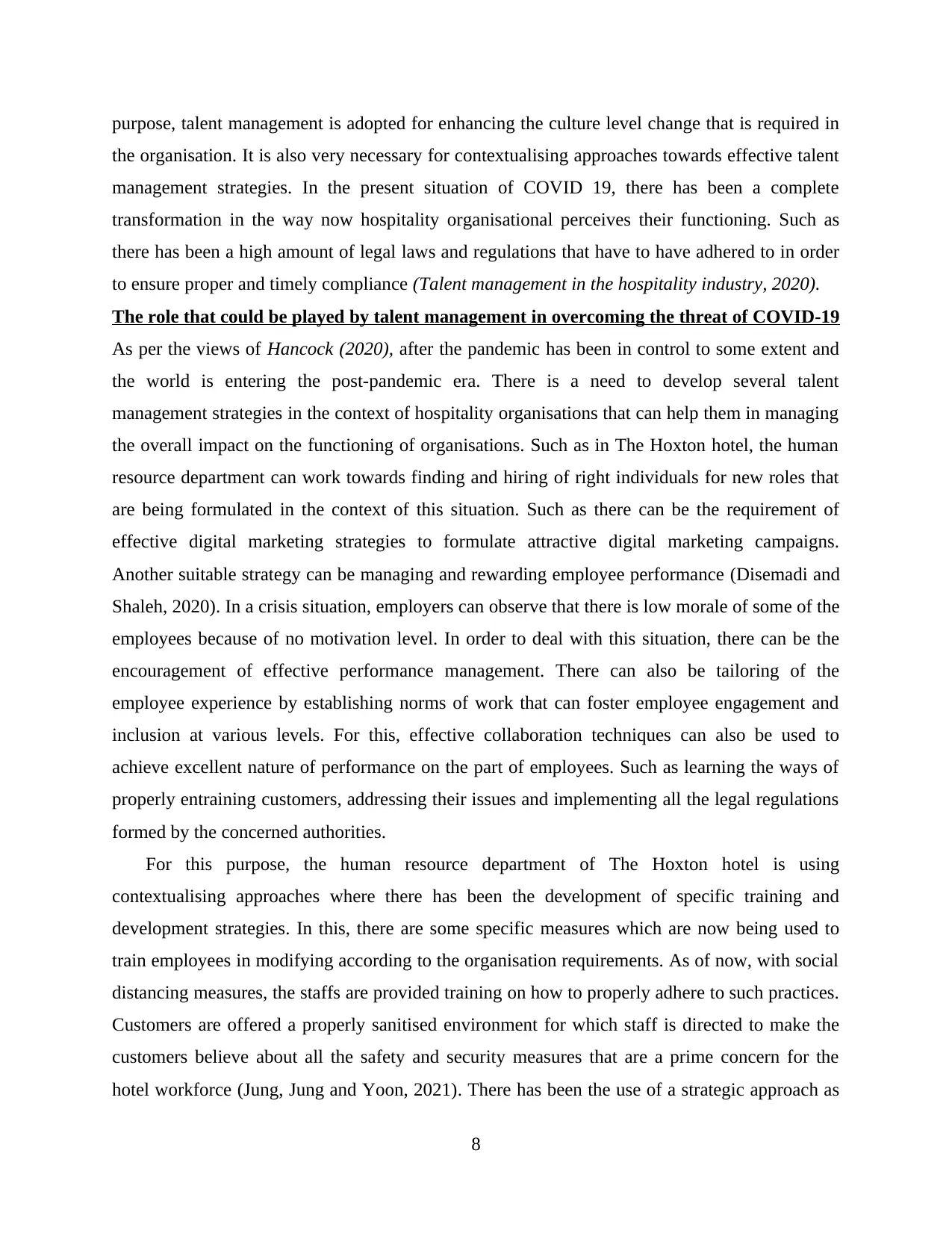
purpose, talent management is adopted for enhancing the culture level change that is required in
the organisation. It is also very necessary for contextualising approaches towards effective talent
management strategies. In the present situation of COVID 19, there has been a complete
transformation in the way now hospitality organisational perceives their functioning. Such as
there has been a high amount of legal laws and regulations that have to have adhered to in order
to ensure proper and timely compliance (Talent management in the hospitality industry, 2020).
The role that could be played by talent management in overcoming the threat of COVID-19
As per the views of Hancock (2020), after the pandemic has been in control to some extent and
the world is entering the post-pandemic era. There is a need to develop several talent
management strategies in the context of hospitality organisations that can help them in managing
the overall impact on the functioning of organisations. Such as in The Hoxton hotel, the human
resource department can work towards finding and hiring of right individuals for new roles that
are being formulated in the context of this situation. Such as there can be the requirement of
effective digital marketing strategies to formulate attractive digital marketing campaigns.
Another suitable strategy can be managing and rewarding employee performance (Disemadi and
Shaleh, 2020). In a crisis situation, employers can observe that there is low morale of some of the
employees because of no motivation level. In order to deal with this situation, there can be the
encouragement of effective performance management. There can also be tailoring of the
employee experience by establishing norms of work that can foster employee engagement and
inclusion at various levels. For this, effective collaboration techniques can also be used to
achieve excellent nature of performance on the part of employees. Such as learning the ways of
properly entraining customers, addressing their issues and implementing all the legal regulations
formed by the concerned authorities.
For this purpose, the human resource department of The Hoxton hotel is using
contextualising approaches where there has been the development of specific training and
development strategies. In this, there are some specific measures which are now being used to
train employees in modifying according to the organisation requirements. As of now, with social
distancing measures, the staffs are provided training on how to properly adhere to such practices.
Customers are offered a properly sanitised environment for which staff is directed to make the
customers believe about all the safety and security measures that are a prime concern for the
hotel workforce (Jung, Jung and Yoon, 2021). There has been the use of a strategic approach as
8
the organisation. It is also very necessary for contextualising approaches towards effective talent
management strategies. In the present situation of COVID 19, there has been a complete
transformation in the way now hospitality organisational perceives their functioning. Such as
there has been a high amount of legal laws and regulations that have to have adhered to in order
to ensure proper and timely compliance (Talent management in the hospitality industry, 2020).
The role that could be played by talent management in overcoming the threat of COVID-19
As per the views of Hancock (2020), after the pandemic has been in control to some extent and
the world is entering the post-pandemic era. There is a need to develop several talent
management strategies in the context of hospitality organisations that can help them in managing
the overall impact on the functioning of organisations. Such as in The Hoxton hotel, the human
resource department can work towards finding and hiring of right individuals for new roles that
are being formulated in the context of this situation. Such as there can be the requirement of
effective digital marketing strategies to formulate attractive digital marketing campaigns.
Another suitable strategy can be managing and rewarding employee performance (Disemadi and
Shaleh, 2020). In a crisis situation, employers can observe that there is low morale of some of the
employees because of no motivation level. In order to deal with this situation, there can be the
encouragement of effective performance management. There can also be tailoring of the
employee experience by establishing norms of work that can foster employee engagement and
inclusion at various levels. For this, effective collaboration techniques can also be used to
achieve excellent nature of performance on the part of employees. Such as learning the ways of
properly entraining customers, addressing their issues and implementing all the legal regulations
formed by the concerned authorities.
For this purpose, the human resource department of The Hoxton hotel is using
contextualising approaches where there has been the development of specific training and
development strategies. In this, there are some specific measures which are now being used to
train employees in modifying according to the organisation requirements. As of now, with social
distancing measures, the staffs are provided training on how to properly adhere to such practices.
Customers are offered a properly sanitised environment for which staff is directed to make the
customers believe about all the safety and security measures that are a prime concern for the
hotel workforce (Jung, Jung and Yoon, 2021). There has been the use of a strategic approach as
8
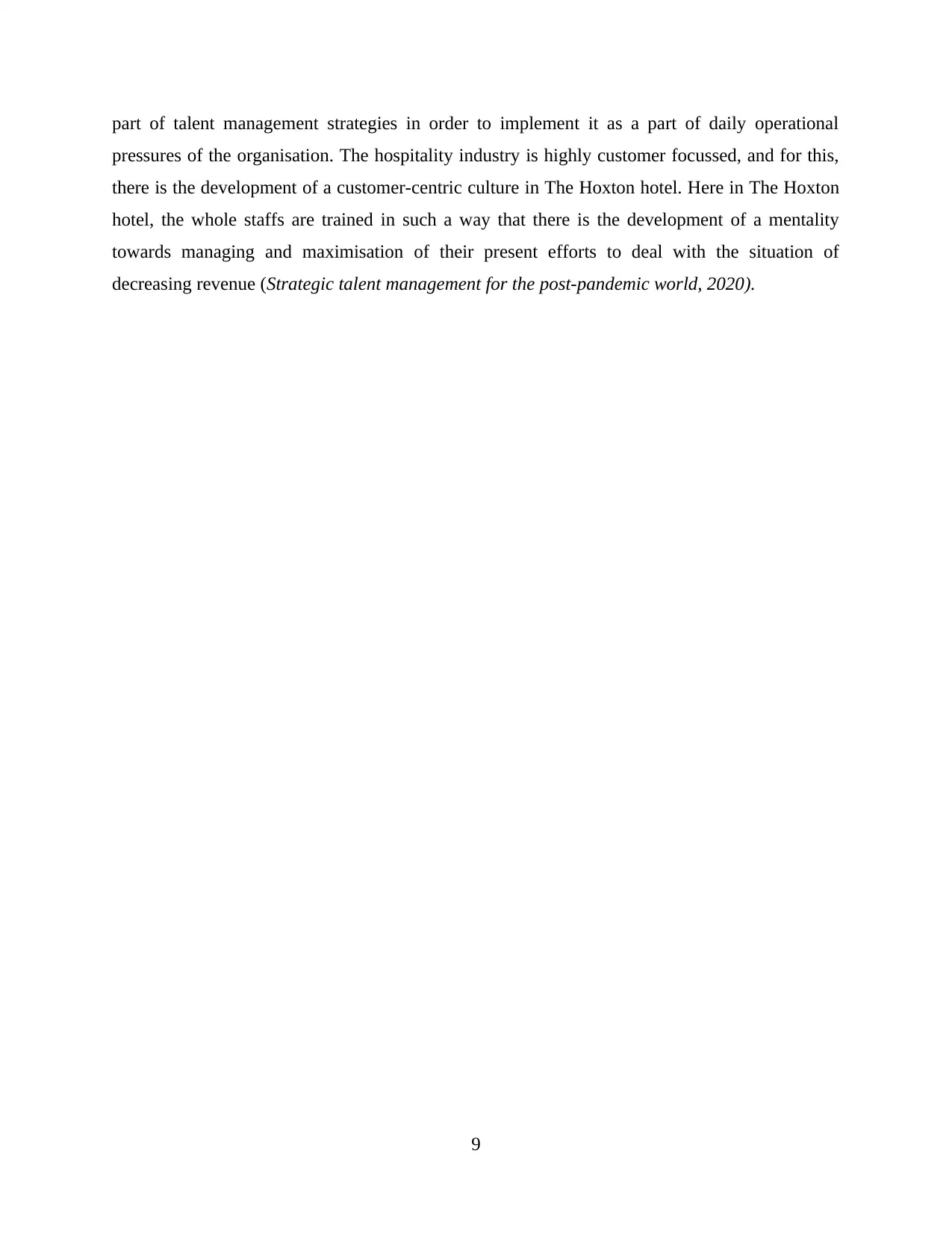
part of talent management strategies in order to implement it as a part of daily operational
pressures of the organisation. The hospitality industry is highly customer focussed, and for this,
there is the development of a customer-centric culture in The Hoxton hotel. Here in The Hoxton
hotel, the whole staffs are trained in such a way that there is the development of a mentality
towards managing and maximisation of their present efforts to deal with the situation of
decreasing revenue (Strategic talent management for the post-pandemic world, 2020).
9
pressures of the organisation. The hospitality industry is highly customer focussed, and for this,
there is the development of a customer-centric culture in The Hoxton hotel. Here in The Hoxton
hotel, the whole staffs are trained in such a way that there is the development of a mentality
towards managing and maximisation of their present efforts to deal with the situation of
decreasing revenue (Strategic talent management for the post-pandemic world, 2020).
9
⊘ This is a preview!⊘
Do you want full access?
Subscribe today to unlock all pages.

Trusted by 1+ million students worldwide
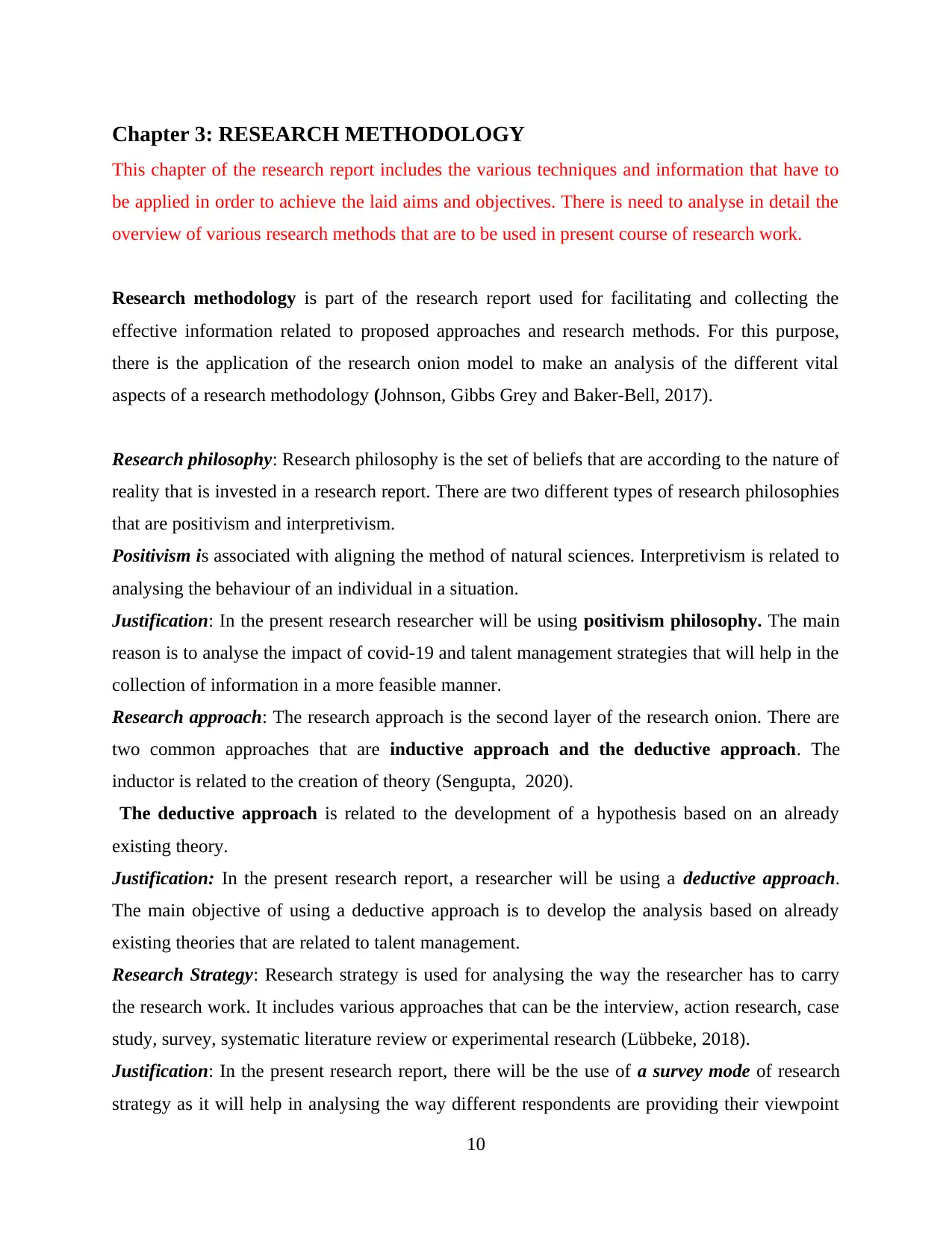
Chapter 3: RESEARCH METHODOLOGY
This chapter of the research report includes the various techniques and information that have to
be applied in order to achieve the laid aims and objectives. There is need to analyse in detail the
overview of various research methods that are to be used in present course of research work.
Research methodology is part of the research report used for facilitating and collecting the
effective information related to proposed approaches and research methods. For this purpose,
there is the application of the research onion model to make an analysis of the different vital
aspects of a research methodology (Johnson, Gibbs Grey and Baker-Bell, 2017).
Research philosophy: Research philosophy is the set of beliefs that are according to the nature of
reality that is invested in a research report. There are two different types of research philosophies
that are positivism and interpretivism.
Positivism is associated with aligning the method of natural sciences. Interpretivism is related to
analysing the behaviour of an individual in a situation.
Justification: In the present research researcher will be using positivism philosophy. The main
reason is to analyse the impact of covid-19 and talent management strategies that will help in the
collection of information in a more feasible manner.
Research approach: The research approach is the second layer of the research onion. There are
two common approaches that are inductive approach and the deductive approach. The
inductor is related to the creation of theory (Sengupta, 2020).
The deductive approach is related to the development of a hypothesis based on an already
existing theory.
Justification: In the present research report, a researcher will be using a deductive approach.
The main objective of using a deductive approach is to develop the analysis based on already
existing theories that are related to talent management.
Research Strategy: Research strategy is used for analysing the way the researcher has to carry
the research work. It includes various approaches that can be the interview, action research, case
study, survey, systematic literature review or experimental research (Lübbeke, 2018).
Justification: In the present research report, there will be the use of a survey mode of research
strategy as it will help in analysing the way different respondents are providing their viewpoint
10
This chapter of the research report includes the various techniques and information that have to
be applied in order to achieve the laid aims and objectives. There is need to analyse in detail the
overview of various research methods that are to be used in present course of research work.
Research methodology is part of the research report used for facilitating and collecting the
effective information related to proposed approaches and research methods. For this purpose,
there is the application of the research onion model to make an analysis of the different vital
aspects of a research methodology (Johnson, Gibbs Grey and Baker-Bell, 2017).
Research philosophy: Research philosophy is the set of beliefs that are according to the nature of
reality that is invested in a research report. There are two different types of research philosophies
that are positivism and interpretivism.
Positivism is associated with aligning the method of natural sciences. Interpretivism is related to
analysing the behaviour of an individual in a situation.
Justification: In the present research researcher will be using positivism philosophy. The main
reason is to analyse the impact of covid-19 and talent management strategies that will help in the
collection of information in a more feasible manner.
Research approach: The research approach is the second layer of the research onion. There are
two common approaches that are inductive approach and the deductive approach. The
inductor is related to the creation of theory (Sengupta, 2020).
The deductive approach is related to the development of a hypothesis based on an already
existing theory.
Justification: In the present research report, a researcher will be using a deductive approach.
The main objective of using a deductive approach is to develop the analysis based on already
existing theories that are related to talent management.
Research Strategy: Research strategy is used for analysing the way the researcher has to carry
the research work. It includes various approaches that can be the interview, action research, case
study, survey, systematic literature review or experimental research (Lübbeke, 2018).
Justification: In the present research report, there will be the use of a survey mode of research
strategy as it will help in analysing the way different respondents are providing their viewpoint
10
Paraphrase This Document
Need a fresh take? Get an instant paraphrase of this document with our AI Paraphraser
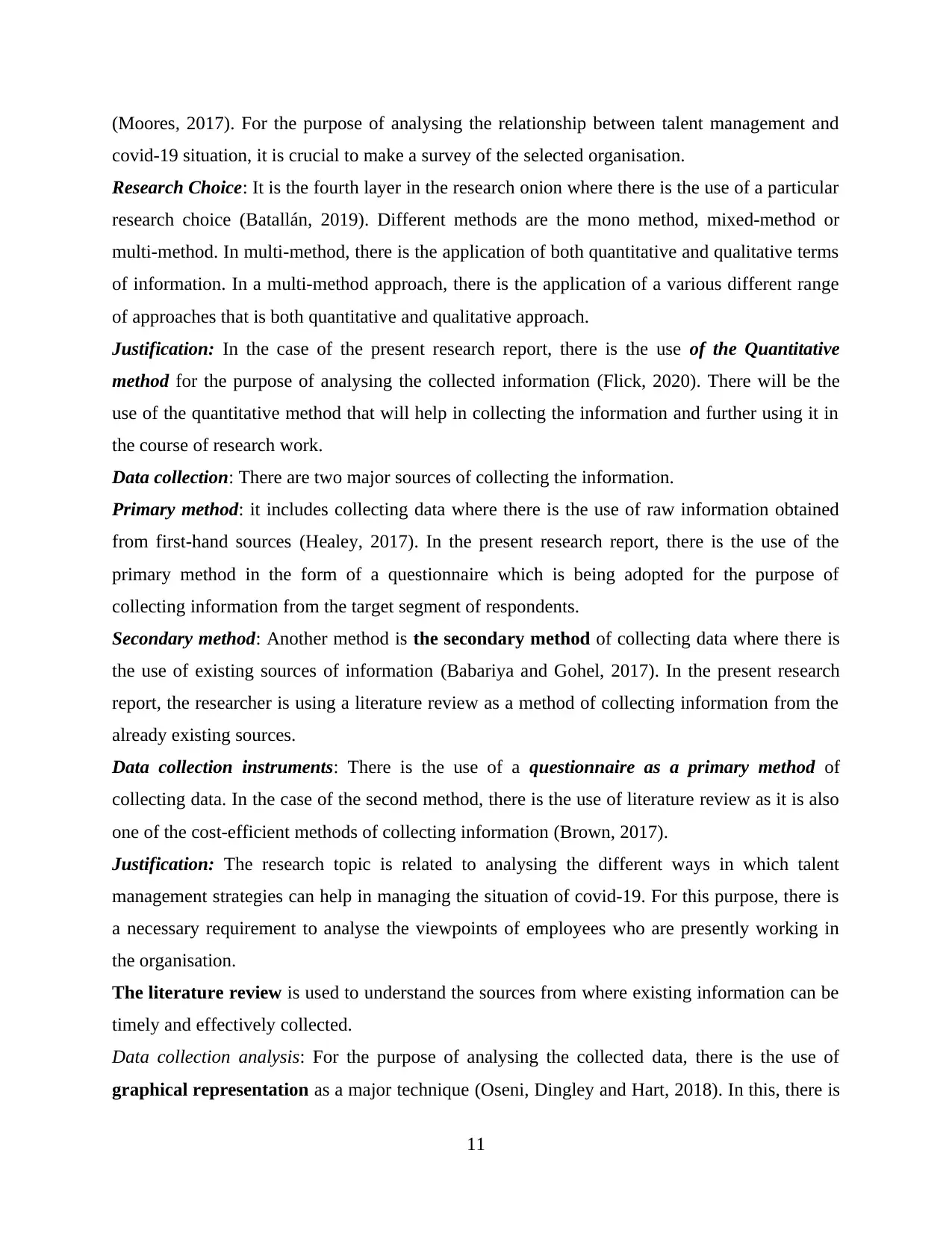
(Moores, 2017). For the purpose of analysing the relationship between talent management and
covid-19 situation, it is crucial to make a survey of the selected organisation.
Research Choice: It is the fourth layer in the research onion where there is the use of a particular
research choice (Batallán, 2019). Different methods are the mono method, mixed-method or
multi-method. In multi-method, there is the application of both quantitative and qualitative terms
of information. In a multi-method approach, there is the application of a various different range
of approaches that is both quantitative and qualitative approach.
Justification: In the case of the present research report, there is the use of the Quantitative
method for the purpose of analysing the collected information (Flick, 2020). There will be the
use of the quantitative method that will help in collecting the information and further using it in
the course of research work.
Data collection: There are two major sources of collecting the information.
Primary method: it includes collecting data where there is the use of raw information obtained
from first-hand sources (Healey, 2017). In the present research report, there is the use of the
primary method in the form of a questionnaire which is being adopted for the purpose of
collecting information from the target segment of respondents.
Secondary method: Another method is the secondary method of collecting data where there is
the use of existing sources of information (Babariya and Gohel, 2017). In the present research
report, the researcher is using a literature review as a method of collecting information from the
already existing sources.
Data collection instruments: There is the use of a questionnaire as a primary method of
collecting data. In the case of the second method, there is the use of literature review as it is also
one of the cost-efficient methods of collecting information (Brown, 2017).
Justification: The research topic is related to analysing the different ways in which talent
management strategies can help in managing the situation of covid-19. For this purpose, there is
a necessary requirement to analyse the viewpoints of employees who are presently working in
the organisation.
The literature review is used to understand the sources from where existing information can be
timely and effectively collected.
Data collection analysis: For the purpose of analysing the collected data, there is the use of
graphical representation as a major technique (Oseni, Dingley and Hart, 2018). In this, there is
11
covid-19 situation, it is crucial to make a survey of the selected organisation.
Research Choice: It is the fourth layer in the research onion where there is the use of a particular
research choice (Batallán, 2019). Different methods are the mono method, mixed-method or
multi-method. In multi-method, there is the application of both quantitative and qualitative terms
of information. In a multi-method approach, there is the application of a various different range
of approaches that is both quantitative and qualitative approach.
Justification: In the case of the present research report, there is the use of the Quantitative
method for the purpose of analysing the collected information (Flick, 2020). There will be the
use of the quantitative method that will help in collecting the information and further using it in
the course of research work.
Data collection: There are two major sources of collecting the information.
Primary method: it includes collecting data where there is the use of raw information obtained
from first-hand sources (Healey, 2017). In the present research report, there is the use of the
primary method in the form of a questionnaire which is being adopted for the purpose of
collecting information from the target segment of respondents.
Secondary method: Another method is the secondary method of collecting data where there is
the use of existing sources of information (Babariya and Gohel, 2017). In the present research
report, the researcher is using a literature review as a method of collecting information from the
already existing sources.
Data collection instruments: There is the use of a questionnaire as a primary method of
collecting data. In the case of the second method, there is the use of literature review as it is also
one of the cost-efficient methods of collecting information (Brown, 2017).
Justification: The research topic is related to analysing the different ways in which talent
management strategies can help in managing the situation of covid-19. For this purpose, there is
a necessary requirement to analyse the viewpoints of employees who are presently working in
the organisation.
The literature review is used to understand the sources from where existing information can be
timely and effectively collected.
Data collection analysis: For the purpose of analysing the collected data, there is the use of
graphical representation as a major technique (Oseni, Dingley and Hart, 2018). In this, there is
11
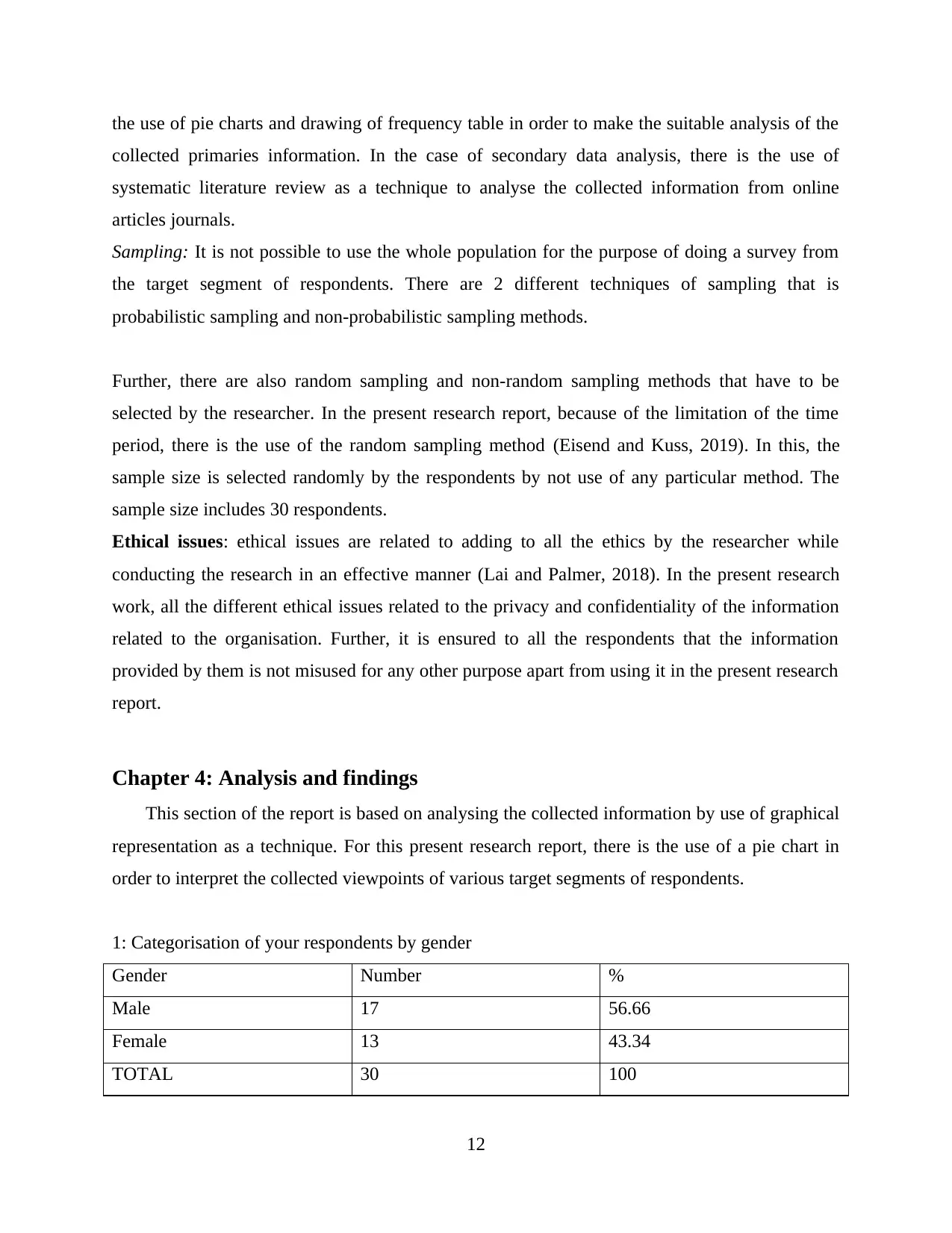
the use of pie charts and drawing of frequency table in order to make the suitable analysis of the
collected primaries information. In the case of secondary data analysis, there is the use of
systematic literature review as a technique to analyse the collected information from online
articles journals.
Sampling: It is not possible to use the whole population for the purpose of doing a survey from
the target segment of respondents. There are 2 different techniques of sampling that is
probabilistic sampling and non-probabilistic sampling methods.
Further, there are also random sampling and non-random sampling methods that have to be
selected by the researcher. In the present research report, because of the limitation of the time
period, there is the use of the random sampling method (Eisend and Kuss, 2019). In this, the
sample size is selected randomly by the respondents by not use of any particular method. The
sample size includes 30 respondents.
Ethical issues: ethical issues are related to adding to all the ethics by the researcher while
conducting the research in an effective manner (Lai and Palmer, 2018). In the present research
work, all the different ethical issues related to the privacy and confidentiality of the information
related to the organisation. Further, it is ensured to all the respondents that the information
provided by them is not misused for any other purpose apart from using it in the present research
report.
Chapter 4: Analysis and findings
This section of the report is based on analysing the collected information by use of graphical
representation as a technique. For this present research report, there is the use of a pie chart in
order to interpret the collected viewpoints of various target segments of respondents.
1: Categorisation of your respondents by gender
Gender Number %
Male 17 56.66
Female 13 43.34
TOTAL 30 100
12
collected primaries information. In the case of secondary data analysis, there is the use of
systematic literature review as a technique to analyse the collected information from online
articles journals.
Sampling: It is not possible to use the whole population for the purpose of doing a survey from
the target segment of respondents. There are 2 different techniques of sampling that is
probabilistic sampling and non-probabilistic sampling methods.
Further, there are also random sampling and non-random sampling methods that have to be
selected by the researcher. In the present research report, because of the limitation of the time
period, there is the use of the random sampling method (Eisend and Kuss, 2019). In this, the
sample size is selected randomly by the respondents by not use of any particular method. The
sample size includes 30 respondents.
Ethical issues: ethical issues are related to adding to all the ethics by the researcher while
conducting the research in an effective manner (Lai and Palmer, 2018). In the present research
work, all the different ethical issues related to the privacy and confidentiality of the information
related to the organisation. Further, it is ensured to all the respondents that the information
provided by them is not misused for any other purpose apart from using it in the present research
report.
Chapter 4: Analysis and findings
This section of the report is based on analysing the collected information by use of graphical
representation as a technique. For this present research report, there is the use of a pie chart in
order to interpret the collected viewpoints of various target segments of respondents.
1: Categorisation of your respondents by gender
Gender Number %
Male 17 56.66
Female 13 43.34
TOTAL 30 100
12
⊘ This is a preview!⊘
Do you want full access?
Subscribe today to unlock all pages.

Trusted by 1+ million students worldwide
1 out of 33
Related Documents
Your All-in-One AI-Powered Toolkit for Academic Success.
+13062052269
info@desklib.com
Available 24*7 on WhatsApp / Email
![[object Object]](/_next/static/media/star-bottom.7253800d.svg)
Unlock your academic potential
Copyright © 2020–2025 A2Z Services. All Rights Reserved. Developed and managed by ZUCOL.





